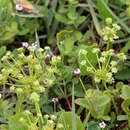Comprehensive Description
provided by North American Flora
Hydrocotyle bonariensis Lam. Encyc. 3: 153. 1789
Hydrocotyle multiflora R. & P. Fl. Per. 3: 24. 1802. Hydrocotyle bonariensis var. multiflora DC. Prodr. 4: 60. 1830. Hydrocotyle bonariensis var. texana Coult. & Rose, Bot. Gaz. 15: 259. 1890. Hydrocotyle umbellata var. bonariensis Speg. Anal. Soc. Ci. Argent. 48: 54. 1899. Hydrocotyle yucatanensis Millsp. Field Mus. Publ. Bot. 2: 81. 1900.
Plants glabrous; stems slender, creeping; leaves orbicularto ovate-peltate, excluding the petioles 1.2-12 cm. in diameter, shallowly 12-19-lobed, the lobes crenate; petioles slender, 2-37.5 cm. long; peduncles longer than the leaves, 2.5-35 cm. long; umbels proliferous, manyflowered; pedicels 2-20 mm. long, spreading and reflexed; involucral bracts lanceolate, acute; flowers white to yellow; stylopodium depressed; fruit ellipsoid, 1-2 mm. long, 2-4 mm. broad, the dorsal surface acute, the dorsal and lateral ribs evident, acute, the commissural surface constricted.
Type locality: "Aux environs de Monte-Video (Uruguay), pres de Buenos Ayres (Argentina), dans les sables voisins de la mer," Sellow.
Distribution: North Carolina to Florida west to Texas, south through Mexico and Central America to Panama; Puerto Rico; South America, to Brazil, northern Argentina Uruguay and Chile. (Curtiss 5932, Pringle 6359.)
- bibliographic citation
- Albert Charles Smith, Mildred Esther Mathias, Lincoln Constance, Harold William Rickett. 1944-1945. UMBELLALES and CORNALES. North American flora. vol 28B. New York Botanical Garden, New York, NY
Hydrocotyle bonariensis: Brief Summary
provided by wikipedia EN
Hydrocotyle bonariensis, the largeleaf pennywort, once a member of the family Apiaceae, now in the family Araliaceae and of the genus Hydrocotyle, is a hairless and creeping perennial.

Hydrocotyle bonariensis

- license
- cc-by-sa-3.0
- copyright
- Wikipedia authors and editors


 Hydrocotyle bonariensis
Hydrocotyle bonariensis 